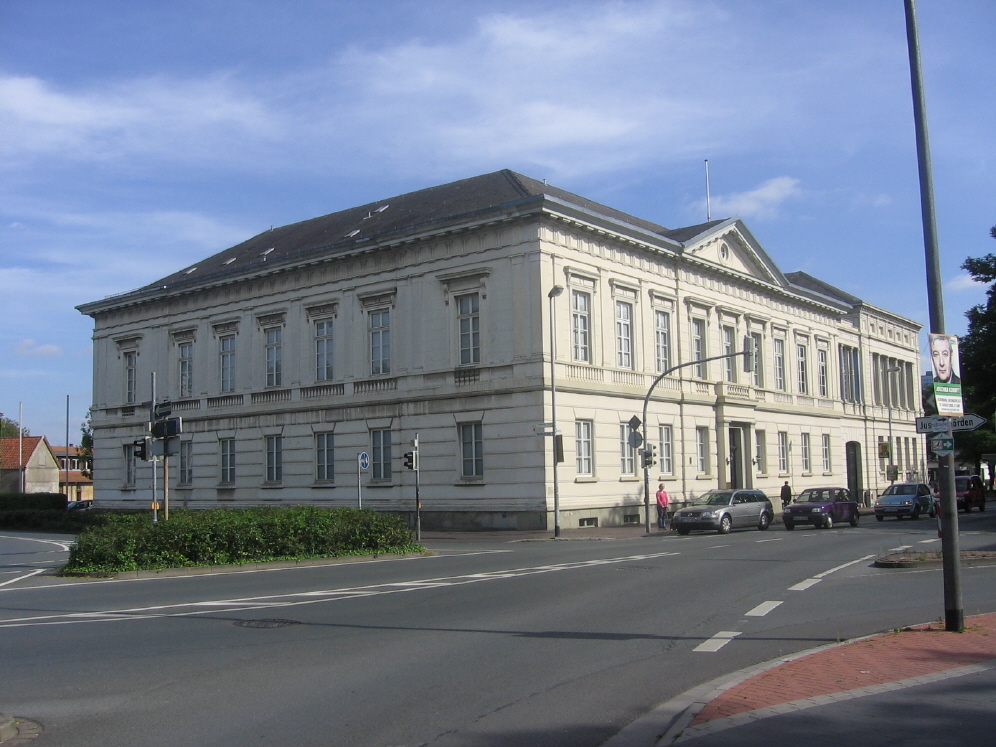Prinzenpalais, Oldenburg on:
[Wikipedia]
[Google]
[Amazon]
 The Prinzenpalais is a
The Prinzenpalais is a
 The Prinzenpalais is a
The Prinzenpalais is a palace
A palace is a large residence, often serving as a royal residence or the home for a head of state or another high-ranking dignitary, such as a bishop or archbishop. The word is derived from the Latin name palātium, for Palatine Hill in Rome whi ...
, now used as an art museum
An art museum or art gallery is a building or space for the display of art, usually from the museum's own Collection (artwork), collection. It might be in public or private ownership, be accessible to all, or have restrictions in place. Although ...
, in the city of Oldenburg Oldenburg may also refer to:
Places
* Mount Oldenburg, Ellsworth Land, Antarctica
*Oldenburg (city), an independent city in Lower Saxony, Germany
**Oldenburg (district), a district historically in Oldenburg Free State and now in Lower Saxony
* Ol ...
, Lower Saxony
Lower Saxony is a States of Germany, German state (') in Northern Germany, northwestern Germany. It is the second-largest state by land area, with , and fourth-largest in population (8 million in 2021) among the 16 ' of the Germany, Federal Re ...
, Germany
Germany, officially the Federal Republic of Germany, is a country in Central Europe. It lies between the Baltic Sea and the North Sea to the north and the Alps to the south. Its sixteen States of Germany, constituent states have a total popu ...
. The museum houses the modern art
Modern art includes artistic work produced during the period extending roughly from the 1860s to the 1970s, and denotes the styles and philosophies of the art produced during that era. The term is usually associated with art in which the tradit ...
collection of the State Museum for Art and Cultural History.
The building dates from 1826 and is in the classical style
Classical architecture typically refers to architecture consciously derived from the principles of Greek and Roman architecture of classical antiquity, or more specifically, from ''De architectura'' (c. 10 AD) by the Roman architect Vitruvius. Va ...
. It was the residence of the Russia
Russia, or the Russian Federation, is a country spanning Eastern Europe and North Asia. It is the list of countries and dependencies by area, largest country in the world, and extends across Time in Russia, eleven time zones, sharing Borders ...
n princes Alexander
Alexander () is a male name of Greek origin. The most prominent bearer of the name is Alexander the Great, the king of the Ancient Greek kingdom of Macedonia who created one of the largest empires in ancient history.
Variants listed here ar ...
and Peter. Subsequently Grand Duke
Grand duke (feminine: grand duchess) is a European hereditary title, used either by certain monarchs or by members of certain monarchs' families. The title is used in some current and former independent monarchies in Europe, particularly:
* in ...
Niklaus Friedrich Peter occupied the building. In 2003, it became part of the State Museum of Art and Cultural History (with the Augusteum
An Augusteum (plural ''Augustea'') was originally a site of imperial cult in ancient Roman religion, named after the imperial title of Augustus. It was known as a Sebasteion in the Greek East of the Roman Empire. Examples have been excavated in ...
and Schloss Oldenburg
Schloss Oldenburg (Oldenburg palace) is a ''schloss'', or palace, in the city of Oldenburg (city), Oldenburg in the present-day state of Lower Saxony, Germany. The first castle on the site was built around 1100 and became the ancestral home of the ...
) and is an art gallery. The museum concentrates on German art
German(s) may refer to:
* Germany, the country of the Germans and German things
**Germania (Roman era)
* Germans, citizens of Germany, people of German ancestry, or native speakers of the German language
** For citizenship in Germany, see also Ge ...
ists, ranging from neoclassicism
Neoclassicism, also spelled Neo-classicism, emerged as a Western cultural movement in the decorative arts, decorative and visual arts, literature, theatre, music, and architecture that drew inspiration from the art and culture of classical antiq ...
and Romanticism
Romanticism (also known as the Romantic movement or Romantic era) was an artistic and intellectual movement that originated in Europe towards the end of the 18th century. The purpose of the movement was to advocate for the importance of subjec ...
in the mid-19th century to the post-1945 era. The Prinzenpalais building is near the northeast corner of the Schlossgarten Oldenburg
The Schlossgarten Oldenburg ("castle garden") is a 16-hectare public park in the city of Oldenburg (city), Oldenburg, Lower Saxony, northern Germany, located between the Eversten district and the city centre to the north. At the northwest end ...
. The Augusteum, Elisabeth-Anna-Palais
The Elisabeth-Anna-Palais is a secular red-brick building in Oldenburg, Lower Saxony, Germany, located at the northeast of the Schlossgarten Oldenburg, close to the Schloss Oldenburg.
History
Usually the ducal family resided in Schloss Oldenburg ...
, and Schloss Oldenburg are all close to the museum.
See also
* Augusteum (Oldenburg), another art gallery close to the Prinzenpalais *List of visitor attractions in Oldenburg
The following is a list of visitor attractions in Oldenburg, Lower Saxony, northern Germany.
Tourist attractions
* Augusteum
* Bahnhofsgebäude
* Edith-Russ-Haus
* Elisabeth-Anna-Palais
* Haus "Degode"
* Haus "Graf Anton Günther"
* Horst ...
* State Museum for Art and Cultural History
References
External links
* 1826 establishments in the German Confederation Buildings and structures completed in 1826 Art museums and galleries established in 2003 Buildings and structures in Oldenburg (city) Tourist attractions in Oldenburg (city) Museums in Lower Saxony Art museums and galleries in Germany Neoclassical architecture in Germany {{LowerSaxony-struct-stub